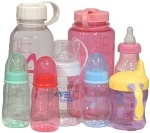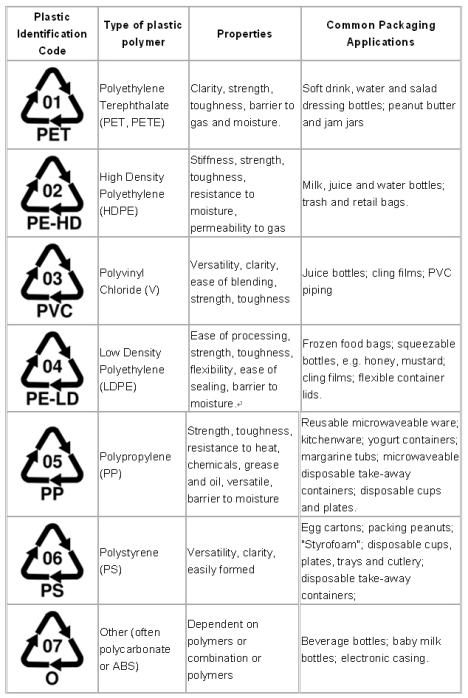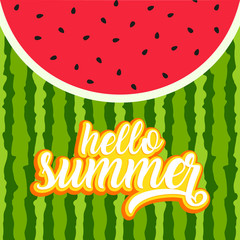 Have you ever noticed or paid close attention to the plastic beverage bottles you buy in a grocery or convenience store?
Have you ever noticed or paid close attention to the plastic beverage bottles you buy in a grocery or convenience store?
Drinks such as water, fruit juice, soda, iced teas, smoothies, etc generally come in plastic bottles.
Have you ever wondered what the ‘number in the triangle’ means or stands for?
There is a number stamped in a triangle (see image below) on the bottom of just about every plastic bottle we use, which varies from one to seven. I’ve read in various sources where claims have been made that the particular number represents the recycling process of the plastic, specifically, the amount of times that exact bottle has been recycled, but in reverse order. Well … yes and no … While it does have everything to do with recycling, the number of times an item has been recycled has absolutely nothing to do with that particular number.
 That number actually represents the type of plastic which is used in the manufacturing of that particular type of bottle. For example, the number ‘5’ is made out of polypropylene (PP) while the number ‘1’ is called PET which stands for polyethlyene terephthalate.
That number actually represents the type of plastic which is used in the manufacturing of that particular type of bottle. For example, the number ‘5’ is made out of polypropylene (PP) while the number ‘1’ is called PET which stands for polyethlyene terephthalate.
The numbers below represent the material (type of plastic) that goes into the making of that specific bottle. This number will be useful for you when sorting through the bottles for recycling, but more importantly, the number will help you to determine which bottle is best for reusing or refilling for your own personal use.
Different types of plastics are sometimes referred to as “resins” and the numeric symbols are known as “Resin ID Codes.”
The following chart represents the ‘Resin ID Codes’ or ‘Plastic Identification Number’ (PIN) found on each plastic bottle.
____________________________________________________________________________________________
# 1 –> PET ….. polyethlyene terephthalate
# 2 –> HDPE ….. high-density polyethylene
# 3 –> PVC ….. polyvinyl chloride
# 4 –> LDPE ….. low-density polyethylene
# 5 –> PP ….. polypropylene
# 6 –> PS/PS-E ….. polystyrene / expanded polystyrene
# 7 –> OTHER ….. resins or multi-materials
* More details/information, as to what types of containers are used for different products, can be found towards the end of this posted article.
____________________________________________________________________________________________
Which plastic water bottles don’t leach chemicals?
Choose your water bottles very carefully in order to prevent chemicals in the plastic from leaching into your water.
 Plastic water bottles are very convenient for carting water around when we are on the go, as they don’t break if we drop them. However, it is worth paying attention to the type of plastic your water bottle is made of, to ensure that the chemicals in the plastic do not leach into the water. If you taste plastic, you are drinking it, so get yourself another bottle.
Plastic water bottles are very convenient for carting water around when we are on the go, as they don’t break if we drop them. However, it is worth paying attention to the type of plastic your water bottle is made of, to ensure that the chemicals in the plastic do not leach into the water. If you taste plastic, you are drinking it, so get yourself another bottle.
To be certain that you are choosing a bottle that does not leach, check the recycling symbol on your bottle. If it is a #2 HDPE (high density polyethylene), or a #4 LDPE (low density polyethylene), or a #5 PP (polypropylene), your bottle is fine.
The type of plastic bottle in which water is usually sold is usually a #1, and is only recommended for one time use. -Do not refill it- . Better to use a reusable water bottle, and fill it with your own filtered water from home and keep these single-use bottles out of the landfill.
Unfortunately, those fabulous colourful hard plastic lexan bottles made with polycarbonate plastics and identified by the #7 recycling symbol, may leach BPA. Bisphenol A is a xenoestrogen, a known endocrine disruptor, meaning it disturbs the hormonal messaging in our bodies. Synthetic xenoestrogens are linked to breast cancer and uterine cancer in women, decreased testosterone levels in men, and are particularly devastating to babies and young children. BPA has even been linked to insulin resistance and Type 2 Diabetes. Nalgene, the company that manufactures the lexan water bottles also makes #2 HDPE bottles in the same sizes and shapes, so we have a viable alternative.
Unfortunately, most plastic baby bottles and drinking cups are made with plastics containing  Bisphenol A. In 2006 Europe banned all products made for children under age 3 containing BPA, and as of Dec. 2006 the city of San Franscisco followed suit. In March 2007 a billion-dollar class action suit was commenced against Gerber, Playtex, Evenflo, Avent, and Dr. Brown’s in Los Angeles superior court for harm done to babies caused by drinking out of baby bottles and sippy cups containing BPA. So, to be certain that your baby is not exposed, use glass bottles.
Bisphenol A. In 2006 Europe banned all products made for children under age 3 containing BPA, and as of Dec. 2006 the city of San Franscisco followed suit. In March 2007 a billion-dollar class action suit was commenced against Gerber, Playtex, Evenflo, Avent, and Dr. Brown’s in Los Angeles superior court for harm done to babies caused by drinking out of baby bottles and sippy cups containing BPA. So, to be certain that your baby is not exposed, use glass bottles.
Check the recycling numbers on all your plastic food containers as well, and gradually move to storing all food in glass or ceramic.
Store water in glass or brass if possible, and out of direct sunlight.
For more information, check out the article/blog from Trusted.MD at the following link:
http://trusted.md/blog/vreni_gurd/2007/03/29/plastic_water_bottles
____________________________________________________________________________________________

Plastic Container Example Guide
Lower Numbers
Numbers 1 and 2 are the most commonly accepted recyclable plastics. These items include bottles for water, soft drinks, salad dressing, vegetable oil, milk, juice, detergent and shampoo.
Higher Numbers
Plastics also can be numbered 3 through 7, and the higher the number, the less likely recycling centers are to take the item. Items with the number 7, for example, are made of miscellaneous plastics and include sunglasses, phones, computer cases and signs.
# 1 – PET: Polyethylene terephthalate ….. Water bottles, carbonated beverages, juices, other soft drinks and oven-ready meal trays.
# 2 – HDPE: High-density polyethylene ….. Bottles for milk, bottled soaps and cleaning liquids.
# 3 – PVC: Polyvinyl chloride ….. Food trays, cling film, mineral water and shampoo.
# 4 – LDPE: Low density polyethylene ….. Carrier bags and bin liners.
# 5 – PP: Polypropylene ….. Margarine tubs, microwaveable meal trays.
# 6 – PS: Polystyrene ….. Yogurt containers, foam trays for meat or fish, hamburger boxes, egg cartons, vending cups, plastic cutlery, protective packaging for electronic goods and toys.
# 7 – Other ….. Any other plastics that do not fall into any of the above categories. An example is melamine, which is often used in plastic plates and cups.
____________________________________________________________________________________________
 More information can be found at these links:
More information can be found at these links:
http://www.thedailygreen.com/green-homes/latest/recycling-symbols-plastics-460321
http://tupperware.com.my/safety_assurance_decoding.php
Filed under: Advice & Wisdom, Health & Safety, Plastics & Recycling | Tagged: are plastic bottles safe, baby bottles, bottles, BPA, direct sunlight, food containers, microwave containers, PET, plastic, plastic codes, plastic containers, plastic cups, plastic cutlery, polyethlyene, recycle, refillable plastic bottles, resin, terephthalate, water bottles, what do the numbers mean |






This information is very educational about plastic.
Very important..I wish you had a tab so one could
e-mail this web site to others..
Can I reuse a #6 plastic drinking cup. Are there health risks ?
Its useful information, Thanks
It is a great discussion. I want to send this information to our friends.It is very useful to us. Read More: manjushree .
I have a tumbler from china with a recycle code. The code # is missing and on the bottom of the triangle are the letters AS. What is this?
good one with useful information…
I’m kinda confuse with these:
“The type of plastic bottle in which water is usually sold is usually a #1, and is only recommended for one time use. -Do not refill it- ”
then
“Numbers 1 and 2 are the most commonly accepted recyclable plastics”
Contradicting!?
Very helpful! Thank you for creating this page.
which one is better to use in fruits juice production, PET OR HDPE
can i use a PET bottle which will store the water from my water purifier for daily use ? is it safe ?
some of the bottles i use at home do not have any indication below .why? are such bottles safe fro storing drinking water? water
thanks for your clear informative article about plastic bottles, now we know what to avoid.
Can u please guide me,How long can we use the bottels indicated by No-1.
I have a makeup remover bottle that holds 6m
Under the bottle it says PETE. Can I re-use the bottle for the same purpose?
[…] waterjugs or containers for water refils in the water fountain. But I was surprised to find through Cool Rain that recycling is not always the best idea. Apparently, bottles with the plastic labeled 1 is only […]